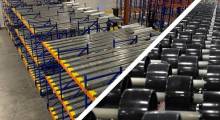At two of its cold storage facilities, Arkansas-based Zero Mountain Cold Storage relied on nearly 600 antiquated 400W metal halide fixtures to light its huge warehouses, one in a former underground limestone mine. New LED high bay fixtures in both facilities now use much less energy and require minimal maintenance.
The previous fixtures consumed excessive amounts of electricity and required near-constant replacement costing as much as $10,000 per year in manpower alone. Because of the lights’ slow warm-up time, Zero Mountain Cold Storage was forced to keep them on 24/7. The old fixtures’ heat output caused the cooling condensers to work even harder, wasting even more energy and producing moisture and frost buildup in some areas.
The new lights (Dialight, dialight.com) reduced energy consumption by 70% and are expected to provide 10 years of maintenance-free performance. With their instant-on capability, the fixtures can also be turned off when not needed or equipped with occupancy sensors to immediately come on at full lumen output.
“Our crews were impressed by how quick and easy it was to change out each fixture, and they’re looking forward to not having to change light bulbs all the time,” says Tony Parrish, facility manager at the Johnson underground location. “This will definitely free up time to perform more critical maintenance needs that contribute to efficient facility operation.”
Because of the improved light output compared to the old fixtures, Zero Mountain was able to reduce the number of fixtures needed to light the same space by more than 20%. With 70% greater efficiency per-fixture, Zero Mountain shaved 1.3 million kWh off its combined energy bill, saving $86,000 in electricity costs alone across the two facilities, bringing total annual savings to nearly $100,000. The addition of occupancy sensors is expected to reduce energy consumption by another 30% to 40%. The company has already approved upgrades at two more sites.







